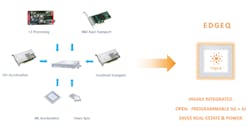Startup Plots Out Programmable Base-Station-on-a-Chip For 5G
A startup is challenging Intel, Qualcomm, and other semiconductor giants with a new system-on-a-chip (SoC) that it claims replaces multiple functions of a 5G base station at a fraction of the power and cost.
EdgeQ, which has amassed over $50 million in funding since it was founded in 2018, is building what it calls a "base station on a chip" that consumes 50% less power in a smaller footprint than rival products in the category. The chip, which is in the final phases of development, features a programmable PHY and it promises to reduce the total cost of 5G base stations up to 50% compared with other products, such as Intel CPUs and Xilinx FPGAs. The chip also builds in artificial intelligence features to give a boost to 5G.
The Santa Clara, California-based startup launched with $38.5 million in its first round of funding last year, bringing its total to $51 million from investors, including Threshold Ventures, AME Cloud Ventures, as well as one of its unnamed customers. The company is headed by ex-Qualcomm executive Vinay Ravuri and it has filled its engineering department with former chip designers from Intel, Qualcomm, and Broadcom.
EdgeQ said that it plans to start sampling the chip to potential customers later this year, chasing industry players including Intel, Xilinx, and Marvell that have a headstart in the $8 billion market for 5G networking equipment. It also announced last month that Qualcomm’s former CEO and executive chairman Paul Jacobs and CTO Matthew Grob, who both left the company in 2018, have joined its advisory board.
The startup stands out from other industry players by using RISC-V, the open instruction set architecture (ISA) that serves as a blueprint for central processing chips. It offers an alternaitve to Intel's X86 and Arm.
Adil Kidwai, vice president and head of product management at EdgeQ, said the baseband modem uses a combination of extended vector extensions and custom instructions on top of its six RISC-V CPU cores to support performance and power profiles unmet by current 5G modems in base stations. He said its cores are custom-designed to handle heavy computational chores, incuding RF signal processing, in 4G and 5G.
The chip also takes advantage of the fact that the computations used in 5G networks largely resemble AI. That means any unused processing power in the RISC-V CPU cores can be reallocated as needed to carry out AI chores. The RISC-V cores can be partitioned into mini-CPUs that run independently of each other. Half of the cores, for instance, could be used to run 5G workloads while the other half handles AI.
A base station is a set of boxes used to connect smartphones and other devices to cellular networks. Today, these boxes are sold primarily by telecom equipment giants such as Nokia, Ericsson, Samsung, Huawei Technologies and other vendors as all-in-one systems. These legacy, monolithic systems tend to be proprietary, with custom-designed chips at the heart of the hardware, which use in-house firmware and software. And these pre-integrated boxes hardware and software clash with packages rolled out by rivals.
There are often "functional splits" within a 5G base station, including the radio unit (RUs) that manages the radio frequency functions and the distributed unit (DU) that handles the baseband processing tasks.
To scale out 5G networks faster and more cheaply, industry leaders are also investing in a standard for open radio access networks, called open RAN. The standard uses open software interfaces to connect all of the building blocks of a base station and make sure that they are interchangeable. That gives telecom companies the flexibility to add features to 5G networks by upgrading the chips inside. A trade-off is that it costs more build out open-standard base stations that are energy-efficient, the startup said.
EdgeQ said its upcoming chip is designed to integrate many of the discrete functions of a base station, ranging from front-haul and mid-haul transport to timing and channel coding to the radio frequency (RF) and baseband functions, into a single chip populated with programmable CPU cores. This translates to savings in power and real estate, and thus, reduces the total cost of 5G base stations over their lifetime.
The startup is wrestling to win slots in 5G base stations over semiconductor giants Intel and Qualcomm. Qualcomm, long the industry leader in smartphone modem chips, plans to start supplying chips for 5G base stations by 2022. Intel hopes to hold 40% of the global market for base station silicon by the end of the year. Programmable chip giant Xilinx is also trying to expand its footprint in 5G infrastructure.
If the new chip can live up to its promises, it could improve the startup's prospects to win business from networking gear makers and telecom companies. The company will also have to compete indirectly with 5G modems custom-designed by Ericsson, Nokia, Huawei, and other telecom gear manufacturers.
According to the startup, one of its advantages is its flexilibity. The modem chip is fully programmable in the popular C and C++ languages, making it easier for original equipment manufacturers and the network operators that buy from them to program more advanced 5G features into the L1 PHY. These include features that could cut 5G network latency or improve positioning, beamforming, and massive MIMO.
That enables the baseband modem to be updated to accommodate upgrades to the 5G standard in the future. In the end, this is cheaper than upgrading the hardware in the base station every couple of years.
The startup also focused on its advantage on the artificial intelligence front. Using AI, the chip could be used to improve massive MIMO, which uses concentrated beams to shoot 5G transmissions directly to devices instead of casting signals in a wide cone like a floodlight. It could also use AI to plot the best transmission route for the beams—called beamforming—to bring more throughout to 5G connections.
There are other ways to combine AI and 5G, the company said. The modem chip could also use AI to identify interference in 5G networks and evade it by moving to frequency bands that are less crowded.
“The advent of 5G comes with changes in the architecture of celluar networks," Jacobs, the former Qualcomm CEO, said in a statement. "EdgeQ's solution, based on the open design of RISC-V processors, enables innovation deeper in the wireless technology stack. This will allow both general performance improvements as well as the design of wireless systems that are tailored to specific use cases."
The startup said the architecture of the modem chip could be adapted in the future for other markets—from factory floors and cars to smartphones and other devices that could be improved with AI and 5G.





